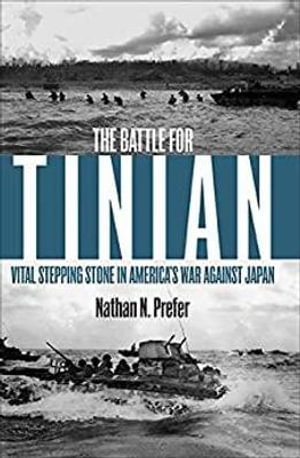
PublishedCasemate, May 2022 |
ISBN9781636241319 |
FormatSoftcover, 264 pages |
Dimensions22.9cm × 15.2cm |
In July 1944, the 9,000-man Japanese garrison on the island of Tinian listened warily as the thunder of the United States Navy and Marine Corps, Army and Air Corps, descended on their neighboring island, Saipan, just three miles away. There were 20,000 Japanese troops on Saipan, but the US obliterated the opposition after a horrific all-arms campaign.
The sudden silence only indicated it was now Tinian's turn. By the time the US 2nd and 4th Marine Divisions switched their sights to Tinian, the island had already been bombarded for a month; meantime both sides had learned their lessons from the previous island-hopping invasions. The Americans had learned the arts of recon, deception, plus preliminary firepower so as not to suffer the huge casualties they'd suffered at Saipan, Guadalcanal, and Tarawa; the Japanese, for their part, had learned not to contest US strength on beaches but to draw it further inland where terrain and bomb-proof fortifications could assist. When the battle for Tinian finally took place the US acted with great skill. Historian Samuel Elliot Morrison called it "the most perfectly executed amphibious operation of the entire war." Nevertheless, the Japanese resisted with their usual stubbornness, and the already decimated US Marines suffered hundreds of more casualties. During the battle Japanese shore batteries were able to riddle the battleship Colorado, killing scores, plus make multiple hits on a destroyer, killing its captain. On the island itself the US used napalm for the first time, paving the way for Marines painstakingly rooting out strongpoints. One last Banzai attack signaled the end to enemy resistance, as Marines fought toe-to-toe with their antagonists in the dark. In the end some 8,000 Japanese were killed, with only 300 surrenders, plus some others who hid out for years after the war. But those Japanese who resisted perhaps performed a greater service than they knew. After Tinian was secured the US proceeded to build the biggest airport in the world on that island - home to hundreds of B-29 Superfortresses. Among these, just over a year later, were the Enola Gay and Boxcar, which with their atomic bombs would quickly bring the Japanese homeland itself to its knees. AUTHOR: Nathan N. Prefer is retired with graduate degrees in Military History. His life-long study of the Second World War has resulted in three prior military studies including MacArthur's New Guinea Campaign, March-August 1944; Patton's Ghost Corps, Cracking the Siegfried Line and Vinegar Joe 's War, Stilwell 's Campaigns in Burma. He resides in Fort Myers, Florida.

